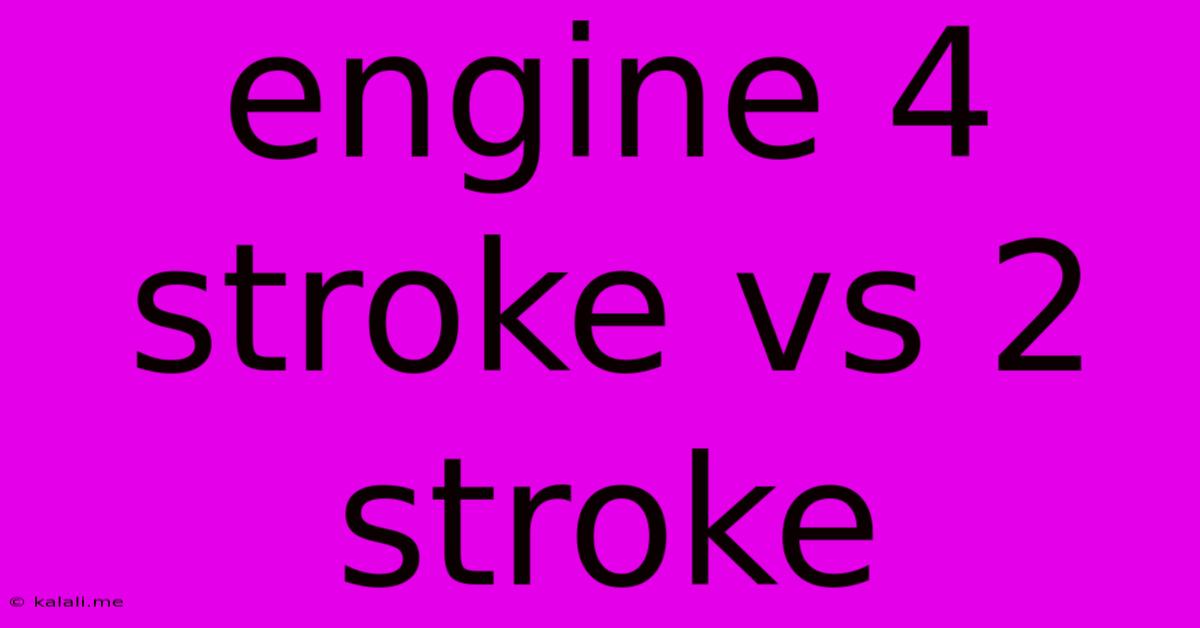Engine 4 Stroke Vs 2 Stroke
Kalali
Jun 01, 2025 · 3 min read

Table of Contents
4-Stroke vs. 2-Stroke Engines: A Comprehensive Comparison
Choosing between a 4-stroke and a 2-stroke engine often comes down to understanding their fundamental differences. Both engine types power a variety of applications, from lawnmowers and chainsaws to motorcycles and outboard motors, but their operating principles, performance characteristics, and environmental impact differ significantly. This article will delve into the intricacies of each, highlighting their strengths and weaknesses to help you make an informed decision.
Understanding the Basics: The Four-Stroke Cycle
The 4-stroke engine completes four distinct piston strokes—intake, compression, power, and exhaust—to generate one complete power cycle. This process is characterized by its efficiency and relatively clean operation.
- Intake: The piston moves downward, drawing a fuel-air mixture into the cylinder.
- Compression: The piston moves upward, compressing the fuel-air mixture.
- Power: The compressed mixture ignites, forcing the piston downward, generating power.
- Exhaust: The piston moves upward, expelling the burnt gases from the cylinder.
Advantages of 4-Stroke Engines:
- Greater Efficiency: 4-stroke engines are significantly more fuel-efficient than their 2-stroke counterparts due to the separate intake and exhaust cycles.
- Higher Torque: They generally produce more torque at lower RPMs, making them suitable for applications requiring pulling power.
- Cleaner Emissions: With separate lubrication systems and more complete combustion, 4-stroke engines produce fewer harmful emissions.
- Longer Lifespan: Typically, they boast a longer lifespan due to less wear and tear on engine components.
- Quieter Operation: Generally, they run quieter than 2-stroke engines.
Disadvantages of 4-Stroke Engines:
- Higher Initial Cost: They tend to be more expensive to manufacture and purchase.
- More Complex Design: The more intricate design leads to higher maintenance costs and repair complexities.
- Heavier Weight: Due to their design, they are usually heavier than equivalent 2-stroke engines.
- Lower Power-to-Weight Ratio: Compared to 2-strokes, they often have a lower power output for a given weight.
Understanding the Basics: The Two-Stroke Cycle
The 2-stroke engine completes the intake, compression, power, and exhaust processes within two piston strokes. This streamlined process contributes to its lightweight and powerful nature. However, it also accounts for its higher emissions and reduced fuel efficiency.
- Upward Stroke: The piston compresses the fuel-air mixture, while simultaneously, the exhaust ports open, expelling burnt gases. Pre-mixed fuel is drawn into the crankcase.
- Downward Stroke: The piston moves down, compressing the fuel in the crankcase. The intake port opens, allowing the fuel-air mixture from the crankcase to enter the cylinder. Simultaneously, the power stroke occurs as the compressed mixture ignites.
Advantages of 2-Stroke Engines:
- Lightweight and Compact: Their simpler design makes them lighter and more compact than 4-stroke engines.
- Higher Power-to-Weight Ratio: They deliver higher power output for their size and weight.
- Simpler Design: Fewer moving parts translates to easier maintenance and repairs.
- Lower Initial Cost: They are generally less expensive to manufacture and purchase.
Disadvantages of 2-Stroke Engines:
- Lower Fuel Efficiency: They consume significantly more fuel than 4-stroke engines.
- Higher Emissions: They produce significantly higher levels of harmful emissions, including unburnt fuel and oil.
- Shorter Lifespan: Due to the constant stress on engine components, their lifespan is shorter than 4-stroke engines.
- Louder Operation: Generally, they are significantly louder than 4-stroke engines.
- Requires Pre-mixed Fuel: The fuel must be pre-mixed with oil, leading to additional complexity and potential for improper mixing.
Conclusion:
The choice between a 4-stroke and a 2-stroke engine depends entirely on the application and priorities. 4-stroke engines excel in applications requiring fuel efficiency, low emissions, and longevity. 2-stroke engines are preferred where lightweight, compact size, and high power-to-weight ratio are paramount, even at the cost of higher emissions and fuel consumption. Understanding these fundamental differences will ensure you select the right engine for your specific needs.
Latest Posts
Latest Posts
-
How To Get Rid Of Garages In Gta Online
Jun 03, 2025
-
How Long After Global Entry Interview For Approval
Jun 03, 2025
-
What Is The God Of Escapes In Greek Mythology
Jun 03, 2025
-
Turnover And Drop Out In Research
Jun 03, 2025
-
Does Glenn Die In Season 6 Of The Walking Dead
Jun 03, 2025
Related Post
Thank you for visiting our website which covers about Engine 4 Stroke Vs 2 Stroke . We hope the information provided has been useful to you. Feel free to contact us if you have any questions or need further assistance. See you next time and don't miss to bookmark.